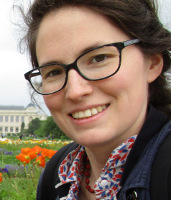Doctorants ILP actuels
traduction en français à venir
 Clotilde Laigle
Clotilde Laigle
I graduated from Ecole Polytechnique Paris Tech where I completed my Master Program in High Energy Physics in 2013. In October 2013, I started my Ph.D. thesis on galaxy evolution at the Institut d'Astrophysique de Paris, with funds from the Lagrange Institute and under the supervision of Christophe Pichon and Henry Joy McCracken.
The dark matter environment of galaxies is thought to control the relative importance of internal and external processes in shaping galaxies properties. Their relative role is still under investigation. Both observers and theoreticians attempt to understand galaxy evolution with complementary strategies. For example, observers derive general galactic properties and study their evolution as a function of halo mass, while theoreticians, with the help of hydrodynamical simulations, also investigate the importance of anisotropic gas infall feeding these galaxies along the cosmic web. The focus of my Ph.D. is to understand and combine these results and strategies.
In the year of 2014 I completed a first theoretical work based on hydrodynamic simulations (Laigle et al. 2015), in which we showed that the vorticity of the large scale dark matter is confined to and aligned with the cosmic web filaments, and is driving the spin acquisition of smaller haloes within these filaments.
Currently, I am exploring high redshift (1 < z < 4) galaxies properties leading a comparative study of real and virtual lightcones. The quality of this study relies on the high photometry accuracy available in the new catalog computed on the COSMOS 2deg2 field (Laigle et al. 2015 in prep) and on the state-of-the-art hydrodynamical simulation Horizon-AGN (1 square degree), performed at IAP, for which I am in charge of the post-processing. The prospect of being able to calibrate the observations and quantify their biases is stimulating. Also promising is the prospect of a direct comparison between the data and our current model in order to make predictions for future surveys. I am also currently working on this simulation to make predictions for 3D-tomographic reconstruction and topological studies of the IGM and CGM from quasars and Luminous Red Galaxies spectra, in which the structure of the density is encoded along the line-of-sight through Ly-alpha absorption lines.
These projects are part of the COSMOS and SPIN(E) collaborations.
Contact:





